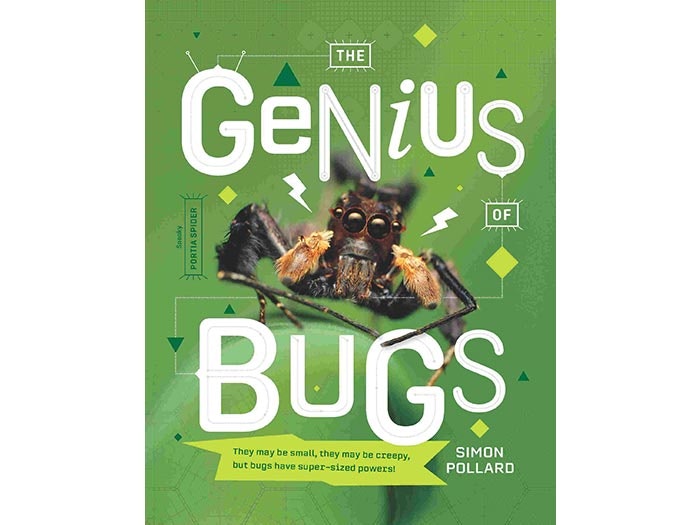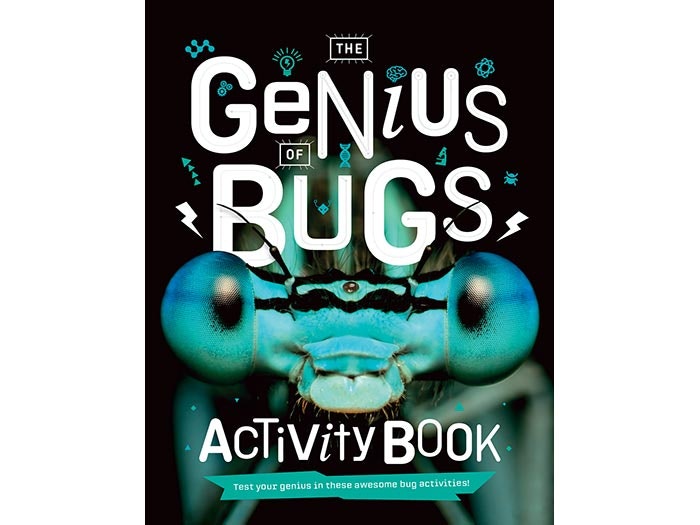
Q&A with Simon Pollard, author of The Genius of Bugs
Simon Pollard discusses The Genius of Bugs with Te Papa Press.
Simon Pollard is a successful children’s book author, spider expert and natural history writer. Currently Adjunct Professor of Science Communication at the University of Canterbury, Simon is the author of the award-winning I Am a Spider (2004) and I Am an Insect (2002). He is a frequent contributor to Natural History (US), and has written for BBC Wildlife (UK), New Zealand Geographic and Nature Australia magazines. Simon has worked as an advisor and script writer for many natural history documentaries, including The Hunt (BBC, 2015) and Planet Earth (BBC, 2006). His book Dear Alison (2009) won the 2010 Children’s Choice Award for non-fiction at the New Zealand Post Children’s Book Awards and the 2010 LIANZA Elsie Locke Award, Non-fiction Book of the Year.
The Genius of Bugs is nominated for the Elsie Locke Award for Non-Fiction at the 2017 New Zealand Book Awards for Children and Young Adults.
"Spiders and insects provide us with stories that are as rich as any story developed purely from the writer's imagination" – Simon Pollard
Of all the genius bugs included in your fact book, which do you think is the most amazing?
We don't think of a five-millimetre wasp as being capable of performing brain surgery more precise than human surgeons can currently achieve. I think what the jewel wasp does to a cockroach’s brain to make it an incubator for the wasp’s offspring and a compliant source of live food is a tale beyond imagination. Sometimes I feel sorry for the cockroach, but that tends to be overshadowed by my huge admiration for the jewel wasp’s surgical abilities.
This is your third book for children about insects or spiders. Why do you think kids are so entranced by creepy crawlies?
I think kids love natural history stories, and the more layers to the story, the better. Spiders and insects provide us with stories that are as rich as any story developed purely from the writer's imagination. When I tell kids about how Japanese honey bees can kill a hornet five times their size without stinging or biting it, they are always at a loss to work out how the bees do it. When I tell them they cover the hornet in a ball of bees and generate enough heat to cook it, they are thrilled by such an ingenious weapon.
Why spiders? What about them first intrigued you?
I wanted to be a zoologist from the age of seven, largely through the influence of my uncle Jim Pollard, who was an animal psychologist at the University of Canterbury. Jim also introduced me to the classic horror films, including Dracula and Frankenstein, and I developed a love of animals and creatures that went bump in the night. When I was a third-year zoology student at the University of Canterbury, I realised I wanted to study spiders. Their lifestyle appealed to me given it fitted both childhood fascinations. In the following year, spider biologist Robert Jackson came to join the university’s zoology department and I became his apprentice. Robert taught me that spiders are wonderful tools for understanding evolution, and most of my spider projects in the tropics have been with him.
Tell us about your pet spider?
I have always been very careful not to deliberately hurt spiders or destroy their webs. When my wife and I moved house, I brought around 20 common house spiders with me. They had been living outside our lounge window, and you could hardly see through the glass because of the density of their silk. I thought it was unlikely that the new owners would share my fondness for a window that looked like it was out of a horror film. Recently a spider moved into the corner of our kitchen, where she’s been allowed to stay, provided I clean up her poop and her preys’ leftover body parts. The spider’s name is Norma, which is a homage to Norman Bates from the film Psycho, who moved as quickly as a spider when he dressed up as his mum and killed those who wanted to mess up his Mother's Day.
How have you found working on The Genius of Bugs book alongside the Bug Lab exhibition at Te Papa?
Wellington has been my home two days a week for almost a year, and I could not have wished for two better projects. I have loved working with the team at Te Papa and Weta Workshop on the Bug Lab exhibition. It just pushes all my buttons. I have also loved working with Senior Editor Catherine Cradwick at Te Papa Press, who has been an amazing editor. I love being busy and work best under pressure. The rewards of seeing the exhibition and book come together have been very pleasing.
Is studying bug genius the answer to enhanced technology and medicine in the future?
The technology developed over the last decade that has allowed us to understand the lives of bugs will pave the way for bug-inspired technology and medicine in unimaginable ways. For example, to understand how the jewel wasp injects venom into the cockroach's brain so precisely, scientists made the wasps radioactive so they could see specific hot spots in the injected cockroach’s brain. They discovered that the wasp's stinger has sensors that can find particular areas of the brain, and they now know how the wasp's venom causes the cockroach’s behavioural changes. Could a sensory needle the exact same diameter as the wasp's stinger have applications in neuroscience?
You have travelled all around the world researching spiders. Where is the best place to go to find fascinating bugs?
I have always loved being in the tropics, where the animal biodiversity is astounding. I was on a research project in Kenya for a small jumping spider, which has a predilection for human blood and preys on blood-sucking mosquitoes. While the tropics have a huge number of wonderful bug stories, so do the temperate rainforests of New Zealand. I once studied a native harvestman from the South Island's West Coast. The male harvestmen have ridiculously large mouthparts for impressing females. In contrast to travelling to the tropics, I could get in my car and drive for only three and a half hours and be in West Coast rainforest, which held a story to rival the best of them. And don't forget the garden at home – for bugs, it really is a jungle out there.
Is writing for children as fun as it seems?
I love writing kids’ books. I tend to think about the details of what I want to say, and then I get into a zone that produces a style of writing suited to the audience. I especially like coming up with examples of what it would be like if humans shared the experiences of bugs. My favourite example from The Genius of Bugs is when I liken the attractiveness to pollinating insects of the irresistible but predatory orchid mantis to how kids might react to the sight of giant, balloon-sized jelly beans.
What's the best feedback you've received from your young readers?
I remember being at a Storylines Book Festival a number of years ago. On the last day, the public could come and meet the writers and I was paired with Margaret Mahy, who had a queue which extended to the top of the North Island. At one point, my queue was one eight-year-old boy, who told me how much he loved my book I Am a Spider, and I remember feeling very proud. I was also pleased when after I Am a Spider won the LIANZA Elsie Locke Non-Fiction Award, Elsie Locke's daughter told me how much her kids enjoyed the book.
Aside from The Genius of Bugs, what's the best book on insects or natural history you've read?
Richard Dawkins' The Greatest Show on Earth is a wonderful testimony to the evolution of life on earth and the richness it has produced.
You might also like


The Genius of Bugs
They may be small, they may be creepy, but bugs have super-sized powers!

The Genius of Bugs Activity Book
Test your genius in these awesome bug activities.